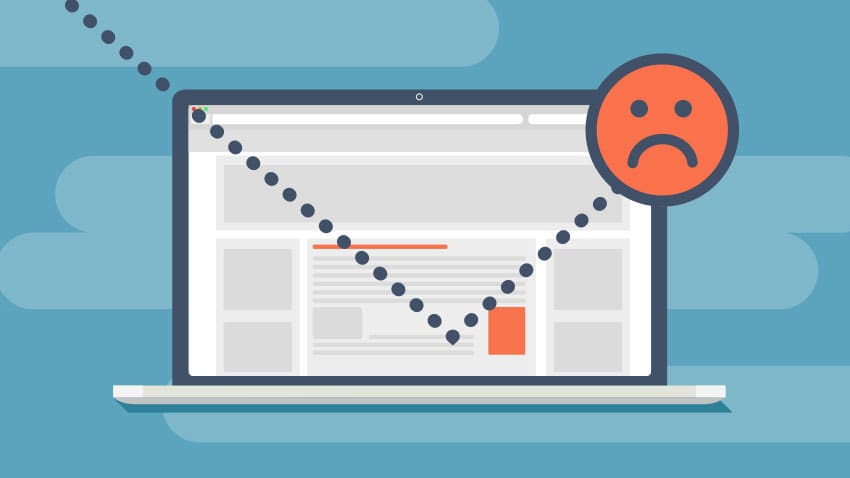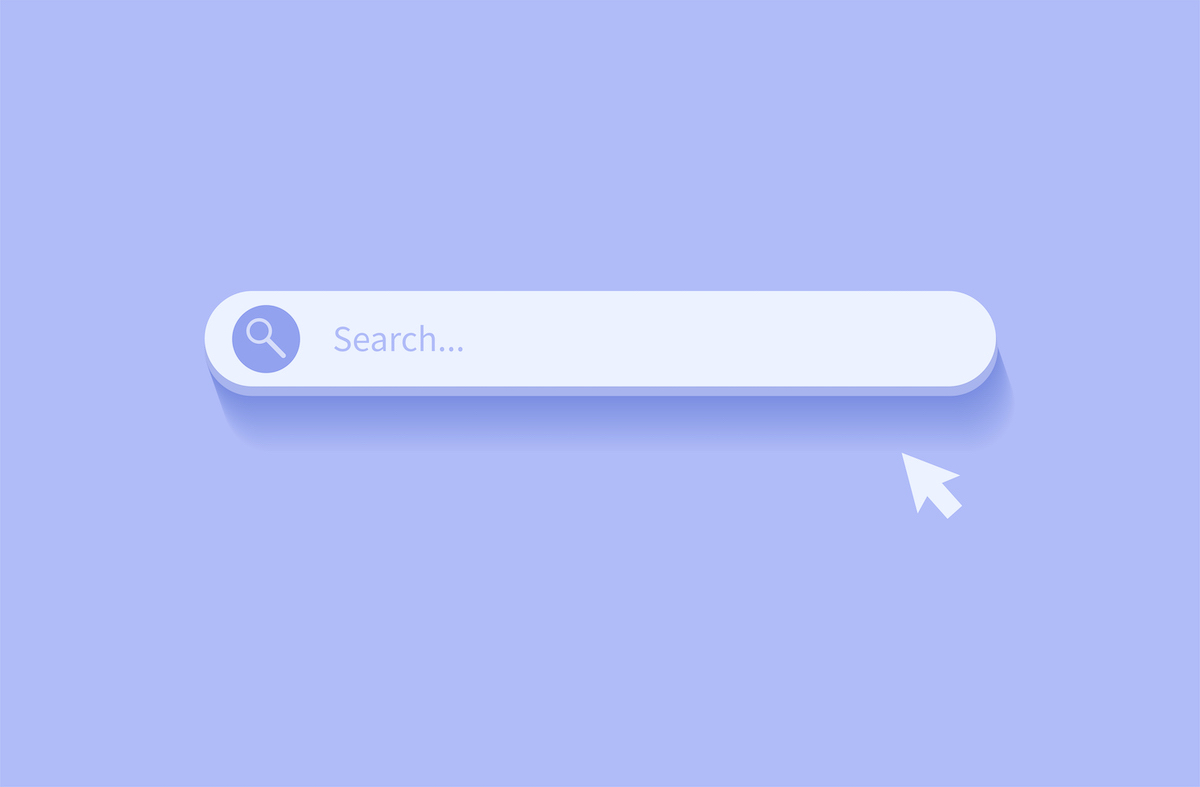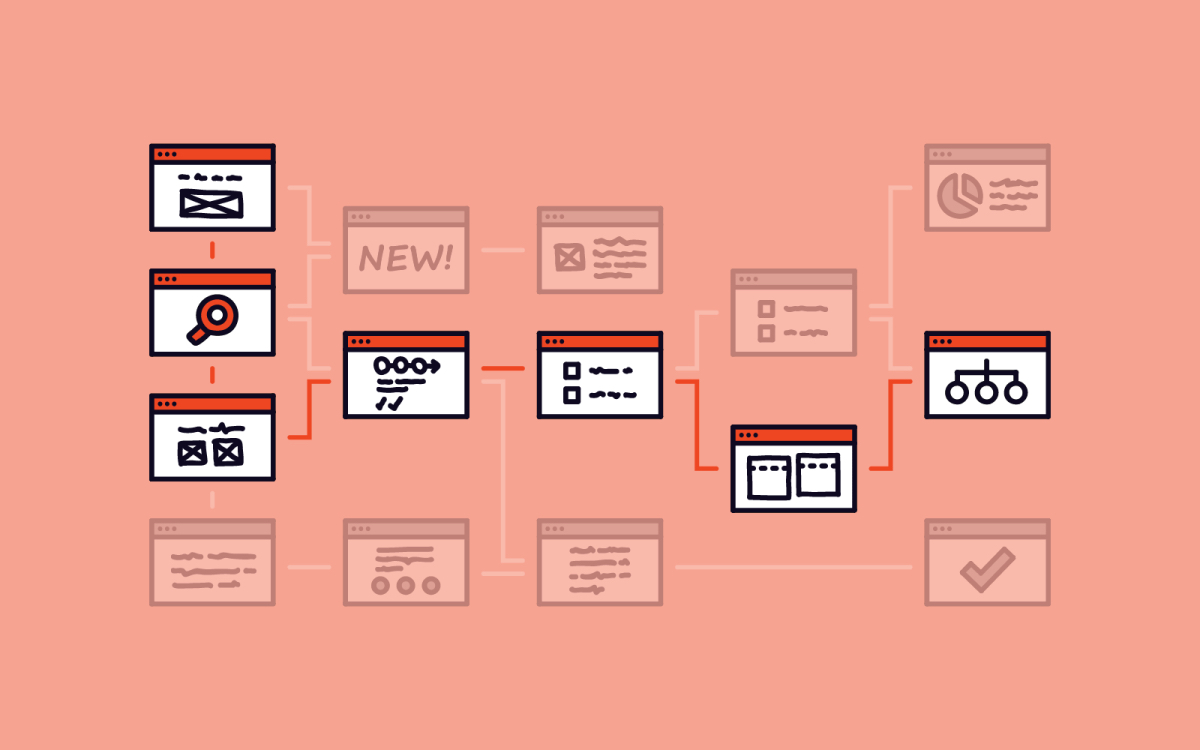Don’t Leave!
Bounce rate is one of the few website metrics that, contrary to others like conversion rate or time on site, you will typically want to focus on reducing as opposed to increasing.
What Does Bounce Rate Mean?
Bounce rate is a website metric that describes the percentage of visitors who leave your website without first going to another page.
In other words, visitors come, aren’t convinced to stay or convert, and leave.
Bounce rate percentages will signify different things for different websites, and should be cross-referenced with other metrics to get a clearer picture of how visitors are really interacting with you, but in general, a high bounce rate will indicate one of the following:
- On the positive: Your website immediately delivered what your visitor needed and they were able to access it with no extra steps
- On the negative: Your website didn’t meet your visitors’ expectations and they bounced to find a website that would
Spoiler alert: the second option is much more likely.

Why Does Bounce Rate Matter?
Your website analytics give you valuable insights on the ways that visitors interact with your website, and bounce rate is no exception.
The more you understand how users respond to the way your website is set up, the more you can tailor your experience to what your customers want, increasing your likelihood of generating conversions.
Bounce rate specifically helps you to identify factors which are driving traffic away from your website.
What is a Good Bounce Rate?
The standard for what constitutes a “good” bounce rate percentage will vary depending on the type of website content you produce and your business goals, but as a general rule, a bounce rate of between 26% and 40% is an ideal range to live in. If your bounce rate is over 70%, more often than not, that’s something you’ll want to take a closer look at.
Though it is not as easy for Google Analytics to measure as other quantifiable metrics, such as dwell time, an improved bounce rate still generally equals an improved user experience, and should be something to strive for.
Luckily, this handy guide is here to help!

When you can pinpoint barriers that are preventing your users from gaining value from your website, you can fix them and improve the experience from both ends.
Here are 15 reasons your visitors may be bouncing from your website, and how to encourage them to stay.
How to Reduce your Bounce Rate
1. Use Google Analytics
The first step to improving your bounce rate (or indeed any of your website metrics) is to know and understand the exact data. Google Analytics and other tracking tools are a great way to measure the web traffic coming to your site: what demographics your primary audience belongs to, how long (if at all) they are staying on your website, and which pages are causing them to leave.
Through looking at your data over time, you can start to get a better picture of what your audience wants from your website, which areas you are doing well in, and which areas need improvement.
Unsurprisingly, if you fix the problems that are causing your users to bounce, your other metrics will improve too – and you’ll have cold, hard data to prove it!

2. Improve Your Website’s Speed
Before looking at the quality of your content or any other on-page solutions to improve your bounce rate, consider that visitors may not even be viewing your website at all due to slow load times. The modern web user has incredibly low patience and simply will not stick around for more than two or three seconds to find out if a slow website’s content is worth it.
Tools such as Pingdom Website Speed Test or GTmetrix allow you to accurately test your website’s speed and see the areas that need improving.
Taking actions such as reducing your image and file sizes, removing unnecessary plugins, and limiting ads on your page can help improve its loading speed and increase the number of visitors who actually get eyes on your site.
3. Optimize Your Call to Action
Often, the problem with your website is not that it has no compelling content, but that you are not directing your visitors to take any action upon consuming it.
Choose one strong call to action to emphasize per page, encouraging your visitors to engage with your website in a specific way.
Upon choosing your call to action (hint: make it align with your business goal for that specific page – for example, if you want to increase appointment bookings, encourage your visitors to “book today!”), make sure you optimize where you place it on your web page. Focus on areas of your website that draw the most attention to your users in order to keep them engaged.

4. Target Your Landing Pages
The larger and more diversified your audience is, the more you will need to target the experience of each visitor in order to create the most relevant experience for them. Landing pages that are too generalized will not meet your audience’s needs the same way a targeted page would.
For example, if you are an e-commerce store which has web customers shopping from various countries, make sure that your products and sales are displayed with the currency they will be using to purchase from you. Small details like this will greatly improve their user experience.
In general it is also a good practice to target your audience more specifically regardless, as a high quality audience is always more valuable than a high quantity one. Consider the niche problem(s) that your website specifically is aiming to solve, and then target the core audience who would be looking for those solutions.
When you tailor your website for a specific type of visitor, they will be much more engaged once they find you.
5. Use Relevant Keywords
Search engines provide web visitors with results based on relevant keywords – words which describe the specific content they are trying to find.
When you include keywords that match what your audience is searching for in your content, there is an increased likelihood that the search engine will display your website to your customers, and that they won’t bounce when introduced to your site.
However, if your keywords do not match what users are searching for, or if your content is irrelevant to the keywords you are targeting, you will end up with a lot of disappointed visitors bouncing from your website.
Stay on topic and make sure that your content aligns with the terms your audience is searching for.

6. Improve Your Website’s Readability
Having valuable, targeted content on your website is only half the battle if your audience is struggling to read it.
A lot of times, bounce rate has more to do with the content formatting of your web page as opposed to the quality of the content itself.
Web visitors, as we already established, are impatient – they are skimmers as opposed to readers, and if they can’t absorb your content with as little effort as possible, they simply won’t.
Huge chunks of text are intimidating and overwhelming to the average web browser, and will not capture their attention in order to convince them to read it all anyway. Eye-catching headings, relevant subtitles, highlighted text, and short paragraphs will make your content much more accessible, and provide a much more pleasant user experience.
7. Improve Your Website’s Search-ability
Sometimes your landing page will not immediately display the exact information your visitors are looking for, and if they see no easy way to go about getting it, they will bounce.
Having a search tool that allows your visitors to refine what they need from your site will improve their user experience and decrease your bounce rate.
A search function will increase the visibility of more of your content – content which would otherwise be overwhelming and irrelevant to show all in one place. It will also increase your credibility as a source of information to your visitors as it will show them that there are multiple useful pages on your site that they may find valuable.

8. Improve Your Website’s Navigation
A search function is just one way in which you can improve your visitors’ ability to make their way around your website.
Your website should always guide users with clear directions at all times to wherever they may need to go, and if you make it easy for your visitors to navigate to a secondary page, the act of them doing so will directly correspond to a reduced bounce rate.
Functional menus with segmented page categories in particular will help organize the information on your site so your visitors can successfully find what they need. Make sure the content layout on each page makes sense and directs your users towards a specific call to action with as little effort on their part as possible.

9. Improve Your Website’s Design
People are visual creatures, and a large part of your bounce rate may in fact be to do with your visitors simply not liking what they are seeing.
Attractive websites put users at ease and instill a sense of trust in your company that, at the very least you look like you know what you’re doing.
If your website’s look is outdated, doesn’t match the professional standards of your industry, or doesn’t accurately reflect your brand, your customers will associate those negative first impressions with your company as well.
After all, if your website isn’t great quality on the outside, how can your users expect the content on the inside to match?
10. Make Your Website Responsive
It’s not enough to simply make sure your website looks and works great, but that it looks and works great on all devices.
Responsive design is the practice of creating websites that automatically adapt to the resolution and practical standards of whichever device they are being viewed on, resulting in websites that work seamlessly across desktops, mobile phones, and tablets, with no negative impact to their users.
This is an incredibly important factor to consider when it comes to reducing your bounce rate, as well as according statista.com over half of all website traffic now comes from mobile phone users alone.
As smartphone screens could not be more different than desktop monitors (they are smaller in size, typically portrait instead of landscape, and touchscreen instead of mouse operated), a website that isn’t designed responsively will be virtually impossible to interact with through a mobile device.
Non-responsive websites can cut down on an absurd number of bounces simply by adapting so that their visitors can absorb their content no matter where they are accessing it from.

11. Vary Your Website’s Content
Your website may provide a lot of great, valuable information, but if you’re not presenting it in a way that is interesting and engaging to your users, they won’t care enough to absorb it.
Switching up the various ways you communicate with your users will keep them curious about what you have to say and eager to learn more.
Video is an attention grabbing way to present a condensed amount of information in a short period of time, while helpful images and graphics can illustrate visual data or contribute to your text-based content by breaking it up.
Keep your audience entertained by providing information in a multitude of ways.
12. Use Social Proof
A great way to counter bounce rates is to increase your website’s credibility as a viable source of information, and an effective (and free!) way to do that is to make use of social proof.
Social proof marketing is based on the idea that people will follow the crowd – if your customers see that others are positively engaging with your website, they will be more inclined to do the same.
There are so many examples of social proof, and the most effective types vary depending on the type of business and website you have, but methods such as including positive client reviews/testimonies, displaying any industry awards you may have received, and advertising any impressive statistics that you have accomplished (e.g. shipping to 100+ countries worldwide!) will help keep visitors on your page and out of your competitors’ hands.
13. Reduce Distracting Ads
The last experience any web visitor wants is to click on a website, only to be bombarded with annoying ads.
As much as ads can create revenue for your website, establishing a positive user experience for your visitors needs to come first – after all, do you want the majority of your revenue to come from ads or from satisfied, high-value customers?
Popups and generally aggressive and annoying ad content will distract your audience from the content they clicked on your website to receive, and the more you disrupt your users’ experience, the more likely they are to give up and leave.
The key with ad placement is to be as empathetic and as unobtrusive as possible, limiting popups unless absolutely necessary, and instead focusing on engaging as opposed to distracting your audience.

14. Improve Your Linking
Bounce rates are reduced when a visitor to your website clicks on a secondary link found on your landing page, therefore, it makes sense to improve your linking strategy within your website itself.
Internal links are links to other pages on your website within your current web content or page menus, while external links direct visitors away from your website to other sites they may find useful.
Increasing the number of internal links within your website is a great way to ensure your users are only a click away from the next piece of valuable information you can provide them. However, it’s important not to go overboard or your content will become confusing and unreadable – only link important, high-quality keywords, and ensure that it is as clear as possible to your readers what page they will be taken to once they click your link.
A good way to additionally improve your metrics and user experience is to ensure that any link your users click opens in a new tab. This way, users can still browse the original source of information (increasing the dwell time on that particular page), while absorbing the new source of content at the same time.
One last thing to consider when it comes to linking strategy is of course eliminating any broken links. Links that do not lead anywhere, let alone to where they were advertised, provide a very negative user experience, and will cause users to bounce if you prove that you can’t guide them to the information they need.
15. Consistently Update Your Content
Visitors like to come to websites and see that they are updated regularly with fresh and relevant content.
If users can see that you are posting consistently and actively keeping up to date with both your industry and their specific needs, they will instantly perceive you as more trustworthy, not to mention, they are more likely to return later!
Take a look at what content is resonating with the audience you already have, and consider how you can improve upon it or say something new.
When you convince users not to bounce on your website, then the focus switches to building trust with them, and once you build trust, your conversion rates will start to climb too!
![]()
To Conclude
Your bounce rate is only one of many data-driven metrics that you can look to to analyze your website’s performance among its audience, but it is arguably one of the most important.
Always go back to tip #1 and keep tracking your data to see the ways your website is improving, as well as which methods are working best for you!
Implementing any number of these tips should help to bring your bounce rate down, but remember to always keep trying new things and looking for ways to improve.
Once more visitors start to stay and build trust on your website, make sure to keep your focus on giving them relevant, high quality content that meets their specific needs. Always keep your business goals and the needs of your users in mind, and constantly check in with yourself to make sure they are aligned.
Want a fresh, new website that your visitors would never DREAM of bouncing from? Contact us today to get a free quote and see what we can do for your business and your audience!
